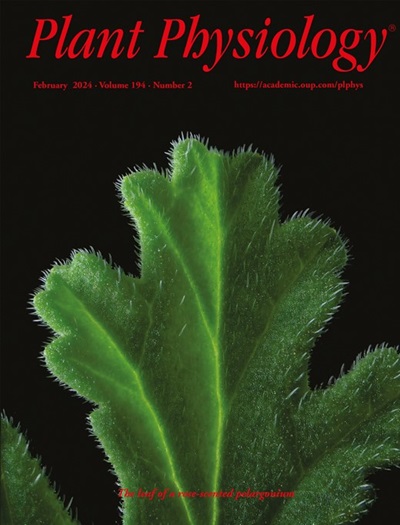Role of polar localization of the silicon transporter OsLsi1 in metalloid uptake by rice roots
IF 6.5
1区 生物学
Q1 PLANT SCIENCES
引用次数: 0
Abstract
Low silicon (Si) rice 1 (OsLsi1) is a key transporter mediating Si uptake in rice (Oryza sativa). It is polarly localized at the distal side of the root exodermis and endodermis. Although OsLsi1 is also permeable to other metalloids, such as boron (B), germanium (Ge), arsenic (As), antimony (Sb), and selenium (Se), the role of its polar localization in the uptake of these metalloids remains unclear. In this study, we investigated the role of OsLsi1 polar localization in metalloid uptake by examining transgenic rice plants expressing polarly or non-polarly localized OsLsi1 variants. Loss of OsLsi1 polar localization resulted in decreased accumulation of Ge, B, and As in shoots but increased Sb accumulation, while Se accumulation remained unaffected under normal conditions. Experiments with varying B concentrations revealed that B uptake is significantly lower at low B concentrations (0.3–3 μM) but higher at high B concentrations (300 μM) in plants expressing non-polarly localized OsLsi1, despite the similar B permeability of both OsLsi1 variants in Xenopus oocytes and their comparable protein abundance in roots. Additionally, the loss of OsLsi1 polarity did not affect the abundance, localization, or high B-induced degradation of the borate transporter 1 (OsBOR1), an efflux transporter that cooperates with OsLsi1 for B uptake. Taken together, our findings demonstrate that the polar localization of OsLsi1 plays a critical role in regulating metalloid uptake, depending on the presence or absence of efflux transporters cooperating with OsLsi1.硅转运体OsLsi1的极性定位在水稻根系吸收类金属中的作用
低硅水稻1号(OsLsi1)是水稻吸收硅的关键转运体。它极局限于根外表皮和内表皮的远端。虽然OsLsi1也可渗透到其他类金属,如硼(B)、锗(Ge)、砷(as)、锑(Sb)和硒(Se),但其极性定位在这些类金属吸收中的作用尚不清楚。在这项研究中,我们通过检测表达极性或非极性定位的OsLsi1变异的转基因水稻植株,研究了OsLsi1极性定位在类金属摄取中的作用。在正常条件下,失去OsLsi1极性定位导致茎中Ge、B和As的积累减少,而Sb的积累增加,而Se的积累不受影响。不同B浓度的实验表明,表达非极性定位OsLsi1的植物在低B浓度(0.3-3 μM)下对B的吸收显著降低,而在高B浓度(300 μM)下对B的吸收较高,尽管两种OsLsi1变体在非洲脚卵母细胞中的B通透性相似,它们在根中的蛋白丰度也相似。此外,OsLsi1极性的丧失并不影响硼酸转运体1 (OsBOR1)的丰富度、定位或高B诱导的降解,OsBOR1是一种外排转运体,与OsLsi1合作摄取B。综上所述,我们的研究结果表明,OsLsi1的极性定位在调节类金属摄取中起着关键作用,这取决于与OsLsi1合作的外排转运体的存在与否。
本文章由计算机程序翻译,如有差异,请以英文原文为准。
求助全文
约1分钟内获得全文
求助全文
来源期刊

Plant Physiology
生物-植物科学
CiteScore
12.20
自引率
5.40%
发文量
535
审稿时长
2.3 months
期刊介绍:
Plant Physiology® is a distinguished and highly respected journal with a rich history dating back to its establishment in 1926. It stands as a leading international publication in the field of plant biology, covering a comprehensive range of topics from the molecular and structural aspects of plant life to systems biology and ecophysiology. Recognized as the most highly cited journal in plant sciences, Plant Physiology® is a testament to its commitment to excellence and the dissemination of groundbreaking research.
As the official publication of the American Society of Plant Biologists, Plant Physiology® upholds rigorous peer-review standards, ensuring that the scientific community receives the highest quality research. The journal releases 12 issues annually, providing a steady stream of new findings and insights to its readership.
 求助内容:
求助内容: 应助结果提醒方式:
应助结果提醒方式:


